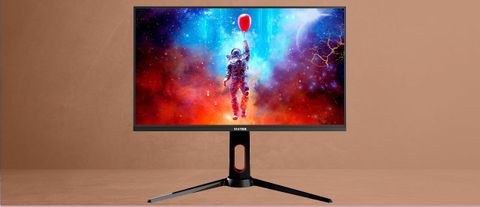Why you can trust Tom's Hardware
To read about our monitor tests in-depth, please check out Display Testing Explained: How We Test PC Monitors. We cover brightness and contrast testing on page two.
Uncalibrated – Maximum Backlight Level
There are a huge number of 27-inch QHD gaming monitors available for sale, and many only cost a little more than the GFI27DBXA. But they do cost more. The Viotek is, so far, the least expensive example we’ve reviewed. Plus, it has the highest refresh rate and one of the largest color gamuts.
For comparison against the GFI27DBXA, we’ve rounded up some rival 1440p 27-inchers, the Gigabyte M27Q, Asus ROG Strix XG27AQ, Acer XV272U KV, MSI Optix MAG272CQR and MSI Optix MAG274QRF-QD.



The GFI27DBXA is the brightest panel here with over 447 nits available in SDR mode. That’s more than enough and a hindrance to going low when gaming in the dark. The minimum brightness is 83 nits, which is a little too much when there’s no ambient light to close the pupils.
This makes the default black level higher than the rest, with contrast a little below average at 909.1:1. Turning on DCR increases the ratio to around 3,000:1, and the dynamic contrast feature is perfectly usable for gaming. However, you won’t want to use DCR in Windows, which will look very bright and lock out the brightness and contrast controls so you can’t compensate.
After Calibration to 200 nits



With all monitors calibrated to 200 nits brightness, the GFI27DBXA is still last in the black level test but only slightly behind the others. However, we’ve picked up a tiny bit of contrast; the ratio is now 941.9:1, closer to the 1,000:1 ratio we look for. Now we’re finally at typical performance for an IPS monitor.
In the ANSI test, we saw a reduction in contrast, due to a few screen-uniformity issues. We’ll detail those on page 5. Perceived contrast in real-world content is better than you’d think from this test, thanks to super-saturated color and very accurate gamma.
Current page: Brightness and Contrast
Prev Page Features and Specifications Next Page Grayscale, Gamma and Color
Christian Eberle is a Contributing Editor for Tom's Hardware US. He's a veteran reviewer of A/V equipment, specializing in monitors. Christian began his obsession with tech when he built his first PC in 1991, a 286 running DOS 3.0 at a blazing 12MHz. In 2006, he undertook training from the Imaging Science Foundation in video calibration and testing and thus started a passion for precise imaging that persists to this day. He is also a professional musician with a degree from the New England Conservatory as a classical bassoonist which he used to good effect as a performer with the West Point Army Band from 1987 to 2013. He enjoys watching movies and listening to high-end audio in his custom-built home theater and can be seen riding trails near his home on a race-ready ICE VTX recumbent trike. Christian enjoys the endless summer in Florida where he lives with his wife and Chihuahua and plays with orchestras around the state.
-
waltc3 400 nits is actually very poor for HDR. It's at the very bottom of the HDR scale, actually. My current monitor is 1015 nits, DisplayHDR 1000 certified--and just off my previous 360 nits "HDR" monitor--I can tell you the comparison is night and day. If you want HDR support, look elsewhere, imo. Just thought I'd mention this as Windows HDR support is now actually pretty darn good these days (latest Win10 builds/Win11 betas). Game developers are at last getting the hang of it!Reply -
Jackson1078 So your monitor is brighter? Big deal. That still doesn’t change the fact that this monitor’s HDR implementation is a lot better then most in its price range and a good number above it. It will still deliver a solid result.Reply
